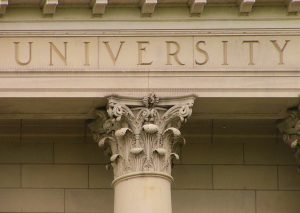 Following the lead of North Carolina last year, members of the Virginia legislature have become the latest to propose legislation to provide students at public colleges and universities the right to attorney representation in on-campus disciplinary proceedings. With narrow exceptions generally arising only at public institutions (e.g., in circumstances where a student faces parallel criminal charges arising out of an incident giving rise to an on-campus proceeding), courts have almost uniformly held that students have no right to counsel during campus disciplinary proceedings. Even in those circumstances where courts have mandated the presence of an attorney, the attorney has been restricted to providing advice to protect the interests of the student, rather than being permitted to perform a formal advocacy role in which he or she presents a defense on a student’s behalf. Like the 2013 North Carolina law after which it appears to have been modeled, the proposed Virginia legislation would change this equation drastically at public institutions. With limited exceptions for charges of academic dishonesty, any student who is accused of a violation punishable by a suspension of greater than 10 days or expulsion would have the right to be represented, at the student's expense, by a licensed attorney (or nonattorney advocate). If present, the attorney would be entitled to "fully participate" during the proceedings, presumably meaning that counsel would be entitled to present opening and closing arguments, cross-examine witnesses (either directly or through the hearing body), make objections, and generally function in a manner similar to defense counsel in a criminal court. If this represents the start of a trend in higher education disciplinary law, it is a concerning one. Colleges and universities do not design their disciplinary systems to function with all of the technicalities of a criminal process, and with good reasons. Campus disciplinary proceedings are designed to be educational in nature, and a core component of the learning experience is a student's ability to speak on his or her own behalf, to take responsibility for his or her behaviors, and to learn from them. Much of this will be lost in the event that students are permitted to have attorneys speak for them throughout the disciplinary process. Reasonable minds can, of course, differ as to whether the foregone educational benefit is outweighed by the need to protect accused students in the context of potentially career-altering additions to their records; however, attorney mandates have other, more significant and less debatable, adverse implications. Ironically, proponents of these legislative efforts have characterized them as “leveling the playing field” between accused students and their institutions, but the presence of active defense counsel would almost certainly swing the balance in the opposite direction, making it both more difficult and more costly for colleges and universities to regulate conduct on their campuses. Indeed, the presence of counsel for accused students may well lead an institution to retain counsel on behalf of the disciplinary panel and/or institutional representatives presenting charges, and to allow student complainants to retain private counsel, turning the entire process into a hypertechnical, confrontational and protracted legal proceeding. The potential costs to institutions, both financial and in terms of the functioning of their disciplinary processes, are not insignificant. It may be that the courts and regulatory authorities in jurisdictions adopting attorney mandates will bring some degree of reasonableness to the analysis; for example, it is possible to argue that the right for an attorney to “fully participate during any disciplinary procedure” means that attorneys can only participate to the extent that an institution’s process otherwise allows any advocate to function in the place of an accused student, and/or that institutions may have procedures that limit the role of counsel (e.g., by precluding cross-examination) provided that the procedural limitations are applied even-handedly. However, this is far from clear, and appears to be contrary to the expectations of those who have sought to implement these reforms. Perhaps more troubling, a mandate to allow active attorney advocacy in on-campus proceedings raises the prospect of serious inequities in the disciplinary process. For example, although the Virginia legislation (like the North Carolina legislation before it) permits the use of "non-attorney advocates," affluent students who are able to retain the highest quality (and correspondingly highest-priced) counsel may have a greater chance of successfully defending disciplinary proceedings and avoiding responsibility for their actions than will students from underprivileged backgrounds. Similarly, these requirements may have chilling effects on institutions’ ability to address allegations of sexual misconduct, where institutions are required to afford complainants rights equivalent to those granted to accused students. Although this may not translate into a requirement that institutions furnish counsel to complainants in such cases (as noted above, accused students are required to pay for their own counsel), many complainants may not have the financial wherewithal or inclination to retain counsel in such circumstances, so as to enable them to have their accounts presented as effectively as those of their alleged assailants or harassers. They may also be understandably fearful of the prospect of being cross-examined by defense counsel (directly or, as is common, through the hearing body) in the manner that often proves traumatic in criminal processes. If this increases the reluctance to report sexual misconduct with which so many institutions already struggle, it will be a truly unfortunate byproduct of these legislative efforts to protect student rights. None of this is to say that accused students are not entitled to a process that is fundamentally fair when facing charges of misconduct; this has always been the law, and students sanctioned by institutions already have the right to seek judicial review of disciplinary determinations in most jurisdictions. Thus, colleges and universities are already accountable for their processes, and should of course take steps to ensure that their proceedings are conducted fairly and even-handedly. Moreover, if institutions are concerned that accused students need legal advice to protect their interests, they always have the option to design their procedures to permit (as many do) the presence of counsel to provide quiet advice to the accused. However, “lawyering up” the entire process by requiring institutions to permit full and active advocacy by counsel would seem, on the whole, to be counterproductive.
Following the lead of North Carolina last year, members of the Virginia legislature have become the latest to propose legislation to provide students at public colleges and universities the right to attorney representation in on-campus disciplinary proceedings. With narrow exceptions generally arising only at public institutions (e.g., in circumstances where a student faces parallel criminal charges arising out of an incident giving rise to an on-campus proceeding), courts have almost uniformly held that students have no right to counsel during campus disciplinary proceedings. Even in those circumstances where courts have mandated the presence of an attorney, the attorney has been restricted to providing advice to protect the interests of the student, rather than being permitted to perform a formal advocacy role in which he or she presents a defense on a student’s behalf. Like the 2013 North Carolina law after which it appears to have been modeled, the proposed Virginia legislation would change this equation drastically at public institutions. With limited exceptions for charges of academic dishonesty, any student who is accused of a violation punishable by a suspension of greater than 10 days or expulsion would have the right to be represented, at the student's expense, by a licensed attorney (or nonattorney advocate). If present, the attorney would be entitled to "fully participate" during the proceedings, presumably meaning that counsel would be entitled to present opening and closing arguments, cross-examine witnesses (either directly or through the hearing body), make objections, and generally function in a manner similar to defense counsel in a criminal court. If this represents the start of a trend in higher education disciplinary law, it is a concerning one. Colleges and universities do not design their disciplinary systems to function with all of the technicalities of a criminal process, and with good reasons. Campus disciplinary proceedings are designed to be educational in nature, and a core component of the learning experience is a student's ability to speak on his or her own behalf, to take responsibility for his or her behaviors, and to learn from them. Much of this will be lost in the event that students are permitted to have attorneys speak for them throughout the disciplinary process. Reasonable minds can, of course, differ as to whether the foregone educational benefit is outweighed by the need to protect accused students in the context of potentially career-altering additions to their records; however, attorney mandates have other, more significant and less debatable, adverse implications. Ironically, proponents of these legislative efforts have characterized them as “leveling the playing field” between accused students and their institutions, but the presence of active defense counsel would almost certainly swing the balance in the opposite direction, making it both more difficult and more costly for colleges and universities to regulate conduct on their campuses. Indeed, the presence of counsel for accused students may well lead an institution to retain counsel on behalf of the disciplinary panel and/or institutional representatives presenting charges, and to allow student complainants to retain private counsel, turning the entire process into a hypertechnical, confrontational and protracted legal proceeding. The potential costs to institutions, both financial and in terms of the functioning of their disciplinary processes, are not insignificant. It may be that the courts and regulatory authorities in jurisdictions adopting attorney mandates will bring some degree of reasonableness to the analysis; for example, it is possible to argue that the right for an attorney to “fully participate during any disciplinary procedure” means that attorneys can only participate to the extent that an institution’s process otherwise allows any advocate to function in the place of an accused student, and/or that institutions may have procedures that limit the role of counsel (e.g., by precluding cross-examination) provided that the procedural limitations are applied even-handedly. However, this is far from clear, and appears to be contrary to the expectations of those who have sought to implement these reforms. Perhaps more troubling, a mandate to allow active attorney advocacy in on-campus proceedings raises the prospect of serious inequities in the disciplinary process. For example, although the Virginia legislation (like the North Carolina legislation before it) permits the use of "non-attorney advocates," affluent students who are able to retain the highest quality (and correspondingly highest-priced) counsel may have a greater chance of successfully defending disciplinary proceedings and avoiding responsibility for their actions than will students from underprivileged backgrounds. Similarly, these requirements may have chilling effects on institutions’ ability to address allegations of sexual misconduct, where institutions are required to afford complainants rights equivalent to those granted to accused students. Although this may not translate into a requirement that institutions furnish counsel to complainants in such cases (as noted above, accused students are required to pay for their own counsel), many complainants may not have the financial wherewithal or inclination to retain counsel in such circumstances, so as to enable them to have their accounts presented as effectively as those of their alleged assailants or harassers. They may also be understandably fearful of the prospect of being cross-examined by defense counsel (directly or, as is common, through the hearing body) in the manner that often proves traumatic in criminal processes. If this increases the reluctance to report sexual misconduct with which so many institutions already struggle, it will be a truly unfortunate byproduct of these legislative efforts to protect student rights. None of this is to say that accused students are not entitled to a process that is fundamentally fair when facing charges of misconduct; this has always been the law, and students sanctioned by institutions already have the right to seek judicial review of disciplinary determinations in most jurisdictions. Thus, colleges and universities are already accountable for their processes, and should of course take steps to ensure that their proceedings are conducted fairly and even-handedly. Moreover, if institutions are concerned that accused students need legal advice to protect their interests, they always have the option to design their procedures to permit (as many do) the presence of counsel to provide quiet advice to the accused. However, “lawyering up” the entire process by requiring institutions to permit full and active advocacy by counsel would seem, on the whole, to be counterproductive.


 Effective June 14, 2014, the
Effective June 14, 2014, the 
 Following the lead of North Carolina last year, members of the Virginia legislature have become the latest to propose
Following the lead of North Carolina last year, members of the Virginia legislature have become the latest to propose  The turn of the calendar to a new year provides an opportunity for New York colleges and universities to perform an early assessment of their compliance with Article 129-A of the New York State Education Law in anticipation of the need to furnish evidence of compliance to the New York State Education Department (NYSED) during the summer of 2014. By way of background,
The turn of the calendar to a new year provides an opportunity for New York colleges and universities to perform an early assessment of their compliance with Article 129-A of the New York State Education Law in anticipation of the need to furnish evidence of compliance to the New York State Education Department (NYSED) during the summer of 2014. By way of background, On October 28, New York State released information necessary for private colleges and universities to begin applying to participate in the
On October 28, New York State released information necessary for private colleges and universities to begin applying to participate in the